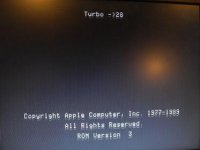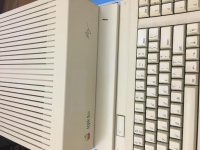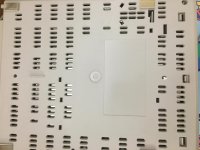28MHz IIgs? nice hidden feature to the ROM3 if it were true.
I don't think so. The 65c816 was only sold with speedratings of up to 10mhz at that time. But the early 65816 was a bugged design that tended to get unstable at higher speeds (>4mhz). The later (currently available) redesign of the 65816 in the late 90s is much more stable and allows speeds of up to 20mhz. Apple did not have a 28mhz cpu available in 1989... and 'tenspeed' is most likely just the chosen divider (28/10) 'tenth of 28'. It may be possible that there were tests with higher speeds when the rom3 was in development. The IIgs has an accelerator already installed to get the 'fast' 2.8mhz and also has the fast memory that can be upgraded to 8Mb. The IIgs is basically a IIe with preinstalled cards (graphics, music, serial and floppy) that has an accelerator with additional fast-memory. You could actually build a IIgs compatible IIe with expansion cards ;-) ... you would have to build a custom accelerator card with fast memory though. The IIgs uses shadowing and buffering instead of cache memory like the ZIPCHIP and Transwarp. The FPI (ROM1) has some modes that are very timing dependent (floppy access) but allow the access of 1mhz hardware at 2.8mhz cpu speed without slowdown. This is because one read access takes enough cycles to be buffered onto the 1mhz Apple II bus. The FPI/CYA is the gatekeeper that controls the access from and to the 1mhz bus. Since the Rom3 has the same memory slot as the rom1, many if not all memory cards would not be compatible if the speed of the cpu/fastmem was increased. The 'Mark Twain' on the other hand had tow normal 30pin simm modules and could have easily implemented higher memory speeds. But Apple never released a turbocharged IIgs with more than 2.8mhz, as far as anyone knows. If someone was cloning the FPI/CYA and design a new version, it would be possible to add other speeds. Fast memory could be a problem, since the expansion cards are designed for the 2.8Mhz CPU.
The FAST side has: CPU, fast memory and the FPI/CYA,
The SLOW has: 128k Slowmem, Audio, Video, Serial, floppy, ... everything else

.
The "Turbo ->28" is strange as well but it could simply be that "28" means "2.8mhz".
The higher speed tests i have heard about (4mhz, 7mhz and maybe 14mhz) were in the initial development of the IIgs in 1985. I suspect that the FPI/CYA are hardcoded to allow only 1mhz and 2.8mhz.
BUT ... i hope i am wrong

-Jonas






